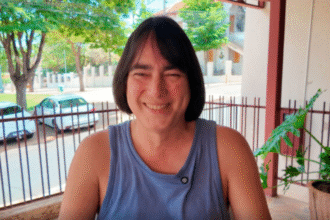Exploring the limits of the human mind, writer Vinicius Monfrinato launches A Garota da Ponte, a novel that delves into the depths of the psychological traumas of its protagonist, Simone. The plot unfolds after a serious accident on the Ponte Estaiada, in São Paulo, which triggers a series of revelations about the abuse and threats that Simone faced as a child. With short chapters and intense dialogues, the book addresses topics such as social inequality, racism, child sexual violence and complex human emotions, highlighting the importance of mental health care. The work, which also offers an interactive experience with playlists , invites readers to reflect on the consequences of a toxic family environment and the search for identity in the midst of suffering.
Can you tell us a little about the creation of the protagonist Simone and the challenges she faces throughout the plot?
This character, in a way, has always been present in my imagination. At first, I was unsure whether she would be a journalist or a confectioner. So I ended up opting for the second option, as I thought it would have more to do with her. From there, I began to bring this complex protagonist to life. The bakery, in reality, was her salvation, where Simone found strength and meaning in her own life to be able to deal with the traces of the traumas she suffered in the past.
In a way, I identified with this character from the beginning, when I found myself at 40 years old completely lost, discouraged and with no perspective on life. That was when I truly listened to myself, allowing me to realize a big dream for the first time: writing a book. I didn’t let fear dominate me and speak louder at that moment. We need to understand that this feeling is not healthy, as it does not allow us to live or have the courage to pursue our dreams.
Stopping to think now, when I started writing this story, thinking I was saving that character from her demons, in reality, she was the one who saved me from myself. In a metaphorical way, the protagonist helped me see my own potential, my determination, my determination and, most importantly, the person I was becoming from that moment on, in which I created strength going against everything and everyone, in realization of my dream. I will be forever grateful that Simone came into my life.
How did you develop the connection between Simone’s self-destructive behaviors and the traumas she carries from the past?
I developed this connection from the research I did to write the story. I needed to understand the horror that victims suffer from sexual violence, which is abominable. Simone’s self-destructive behavior is completely linked to her trauma. We need to understand that some victims feel guilty, ashamed and, often, take a long time to recognize and accept that, in fact, they suffered some type of abuse.
The accident on the Estaiada bridge is a crucial point in history. How did you come up with this idea and what was the desired impact of this event on the plot?
For me, the Estaiada bridge is an important symbol of the city of São Paulo. My idea of putting this crucial point in the story was to connect the characters and the terrible fight they have with a symbol of São Paulo. I would really like this extremely necessary subject to be debated in our society to be marked in people’s memories, so that they can make that connection when they hear about it, or even when they pass through the region, so that they remember the two characters in the book. After all, Simone and Flávia are giving voice to so many other victims out there, who suffer this type of abuse every day.
The book addresses deep issues such as child sexual violence and toxic family environments. How did you approach these sensitive topics and ensure they were treated with due seriousness?
I tried to approach it in the most serious, honest and sensitive way possible. We need to be attentive to every sign that the person may give, even more so when this violence happens inside the house, where this issue is often hidden. Because of this, it becomes much more difficult for the victim to externalize what they are experiencing, for fear of being judged.
The relationship between Simone and Flávia is complex, especially with Marcos’ presence. How do friendship and romantic relationships influence Simone’s narrative and development?
These three characters influence the narrative a lot. The friendship between Simone and Flávia is old, dating back to school. Even though they are friends and like each other, this relationship is still complex. After all, both are victims of sexual violence, and each tries to deal in their own way with the traumas and scars they have acquired throughout their lives.
On one side we have Simone, trying to find her own identity while dealing with self-destructive behavior and the difficulty of expressing her feelings. On the other side, we have Flávia, who despite all the abuse and violence she suffered, never stopped believing in love; for her, her oxygen and her strength come from this feeling.
Marcos was Simone’s greatest love. The boy fell in love with her the moment he saw her on the first day of school, when the protagonist fiercely defended him from the boys who were teasing him because he was the only black student at school. However, life took other directions and, even though she had feelings for Marcos, Simone tried to convince herself that the great love of her life would be better off with Flávia. We just don’t know how much the young baker will be able to handle this situation.

You used QR Codes to include playlists related to the book. How did this idea come about and how does it contribute to the reading experience?
I’m passionate about music. Every day I write, I always have my headphones on listening to my playlist . During the story, some songs are mentioned. I wanted to bring this dynamic and interactive proposal so that the reader could listen to the music mentioned in a certain passage of the plot and, thus, have a greater depth of the moment in which the character finds himself. I believe this enhances the emotion and experience of reading.
What were the biggest challenges in exploring social inequality and racism through the characters and plot?
One of the biggest challenges of exploring the topic of social inequality was seeing that it is spreading more and more in our society, causing serious problems among the population. This ends up reducing people’s motivation to fight for change.
In the story, Marcos’ parents came from humble beginnings. I tried to bring this strength so that they could have this motivation to change the scenario they found themselves in. We know that racism has profound impacts on the mental health of victims, which can generate anxiety, stress, social isolation, depression and harm self-esteem. In the story, Simone plays a fundamental role in showing Marcos that he is much bigger than people might think or think of him.
What message do you hope readers take away from The Girl on the Bridge, especially in relation to the importance of mental health and emotional support?
We know that we live in a chaotic world, increasingly immediate, where everything needs to be done yesterday. We are increasingly focused on ourselves. You always hear that people don’t have time. But have you ever wondered how many hours a day you spend on your cell phone? I guarantee you can take 8 minutes out of your day to talk to another person and ask if they are ok.
The message I would like readers of this book to take away is: give yourself the opportunity to look at the people around you and ask if they are okay. We are often embarrassed or ashamed to say that we are not well. After all, we have the social network showing us all the time that people are happy with their perfect lives.
It seems like no one has a problem or a bill to pay. But, that is not the reality. I think we need to care more about others. Whatever sign the person gives you, it doesn’t hurt to give your emotional support to help the other person. We need to understand that love can often save a life.
Follow Vinicius Monfrinato on Instagram





